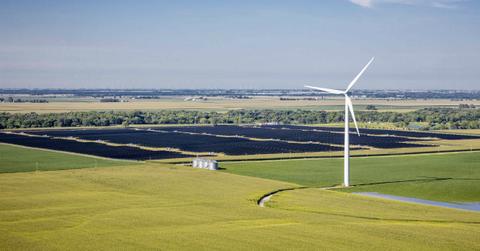How A Renewable Energy Company Is Combining Solar And Wind Power
Invenergy is building a hybrid solar-wind farm in Ohio that could be the largest of its kind, providing clean energy 24 hours a day.
Updated Oct. 10 2018, 2:04 p.m. ET
Generating steady clean energy has always been an issue for engineers, since they’re subject to the fickle forces of nature. The sun is only up for half the day — and even when it is, clouds can get in the way of solar panels converting the light into energy.
Meanwhile, the wind only picks up for limited periods, usually at night, giving turbines a brief window to transform the kinetic energy of the breeze into power.
But what if we could combine solar and wind energy into a hybrid source of electricity? That’s the basic idea behind Invenergy, a Chicago-based firm that’s striving to offer clean energy at all hours of the day.
According to InsideClimate News, Invenergy is currently building an ambitious solar-wind project near Lima, Ohio that could power up to 75,000 homes. The site will place a 150 megawatt solar farm inside a 175 megawatt wind farm, forming what could be one of the largest hybrid renewable energy projects in the world.
Invenergy already has a smaller, similar project in Illinois, located about 80 miles southwest of Chicago. The Grand Ridge Energy Center includes a 210 megawatt wind farm and 20 megawatt solar project, with 31.5 megwatt and 1.5 megawatt storage units to bank the energy generated from both.
But the Ohio project will operate on a much larger scale. Gabe Klooster, a project analyst for Invenergy, told InsideClimate News that it might be the largest hybrid solar-energy project in the world with such a high level of integration and both pieces producing at least 150 megawatts. The solar farm alone will be one of the biggest in Ohio, which has a statewide solar total of 182 megawatts.
Construction on the wind turbines will commence next year, with the solar panels to follow. The Invenergy site is located next to a transmission line, making it easy to send power back to the grid.
The projects are a big step for Invenergy, which built its first wind farm in Tennessee in 2003. Since then, it’s developed 20,415 megawatts of energy that power over 2 million U.S. homes.
“We have reached a tipping point,” Michael Polsky, Invenergy founder and CEO, told Inc. in 2017. “We feel we are simply on the right side of history, rather than the right side of ideology.”
With an estimated $523 million in funding, Invenergy has the potential to develop a lot more hybrid energy projects. But will others follow suit? InsideClimate News points to small solar-wind sites in Chile and Wales, as well as a draft policy in India that encourages the “hybridization” of existing projects and the development of new ones, as evidence of international support.
Combination wind-solar sites could eliminate a long-standing barrier that’s kept renewable energy from widespread adoption. With a solar farm that captures power during the day and a wind farm the generates energy at night, these hybrid projects could provide consistent electricity with no gaps in service. Energy providers are often forced to fill those gaps with dirty power sources, but the work of Invenergy and other innovators might finally change that.


